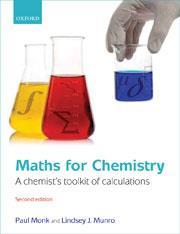Paul Monk and Lindsey J. Munro
Second edition, Oxford: OUP 2010 | Pp281 | £24.99 | ISBN 978 019 954 129 4
Reviewed by Bridgette J. Duncombe

Paul Monk has teamed up with Lindsey J. Munro to prepare a second edition of his highly popular Maths for Chemistry: A chemist's toolkit of calculations.
The second edition has nearly doubled in size relative to the first, owing to the inclusion of some additional topics - both at the introductory and more advanced level - as well as more examples and self-tests. Certainly, some of the advanced level topics go beyond the first year syllabus of most undergraduate chemistry degrees. This is advantageous as many students are unable to purchase multiple support texts alongside the main chemistry textbooks they need. However, there are some peculiarities about both the layout and order of the chapters that will make the book difficult for some students to use.
For example, the chapter titles are neither engaging nor informative but rather an archaic list - perhaps the more descriptive subheadings would have sufficed? Furthermore, the text itself is rather heavy - students, in the main, will have great difficulty in getting the information they want and need easily. On the other hand, the worked examples and asides are clear, useful, and all context-based; although, it would have been preferable to see units used throughout the calculations, (they were removed for clarity) as students do struggle to cancel and complete any subsequent calculation steps. Indeed, it is only in chapter 30, the last chapter of the main text, that dimensional analysis and SI units are dealt with in any detail.
One excellent enhancement to the new edition is the use of diagrams to explain how to use some functions in Microsoft Excel, a package that is in popular use within the UG curriculum. Another welcome addition is chapter 15, Treatment and assessment of errors, although this is a rather cursory glance at the topic.
Overall, the new text is disappointing as the authors have missed the opportunity of a new edition - of what is undoubtedly the main maths support text for undergraduates - to develop the layout of the text and to include tools such as step-by-step guides to calculations as well as the use of colour, for example to highlight units. Nevertheless, the book covers most maths topics required and it will support students through the early years of any undergraduate chemistry course.






No comments yet